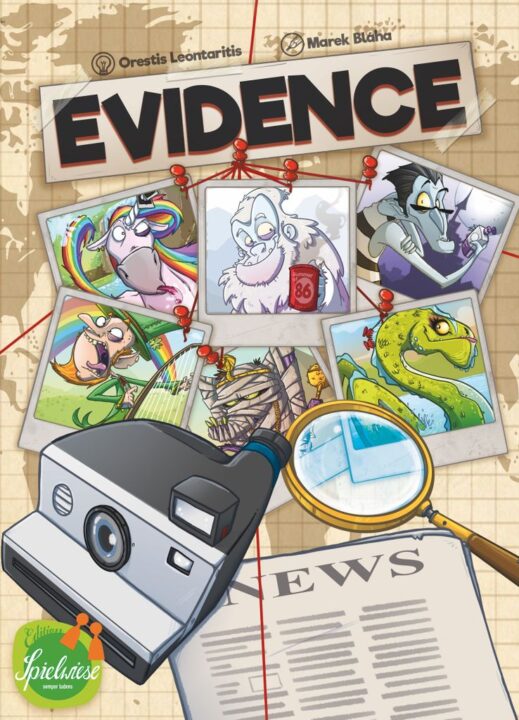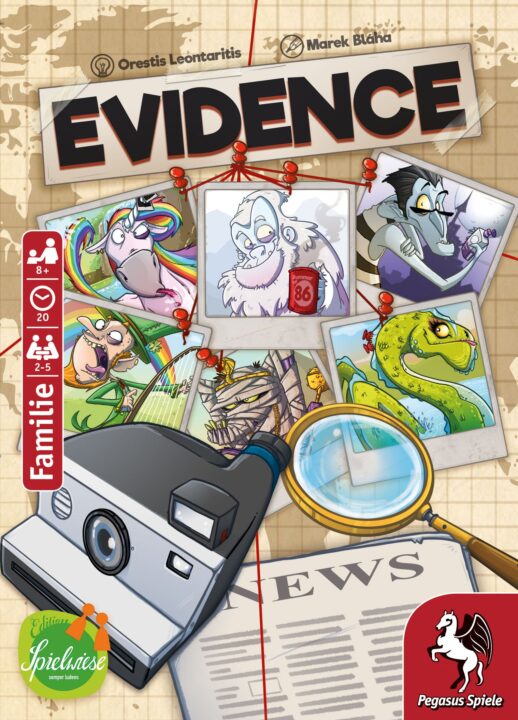Hey folks! Today, I’m diving into our latest board game review: Evidence. If you love deduction games with a twist of mystery, you’re in the right place. With a mix of deduction, strategy, and a dash of luck, it’s a game that’ll have you at the edge of your seat. But don’t let the thrill cloud your judgment; we’ll explore if it’s worth the buzz. So, grab your detective hat and let’s see what Evidence brings to the table!
How It Plays
Setting Up
To start Evidence, get the board out and lay down all the location cards. Each player grabs their detective and a set of evidence cards. Leave some space for the evidence deck.
Gameplay
In the game, players take turns picking evidence cards and trying to piece together clues. You have to keep a poker face and maybe even bluff a little to throw others off. Don’t show all your cards, literally!
Winning the Game
To win, gather enough evidence to make a final accusation. Prove your case before others and you’re the top detective. If you guess wrong, you might end up like that time I thought I lost my keys and they were in my pocket the whole time!
Want to know more? Read our extensive strategy guide for Evidence.
Game Mechanics and Rules: Mastering Evidence
Let me tell you, tackling Evidence is like wrestling a bear… but with more cryptids! This game has a knack for turning the ordinary “me vs. you” into “us vs. the unknown.” You know, the usual Tuesday night at my place. The mechanics in Evidence are simple yet engaging, making you question every move like it’s your last slice of pizza at a party.
The core of Evidence is based on deduction with a sprinkle of luck. Players are investigators trying to uncover the truth about mysterious creatures. You gather evidence cards to prove or disprove these cryptids’ existence. Now, here’s the twist: every player has a unique set of cards. It’s like everyone’s bringing their own secret sauce to the barbecue. But beware! Sometimes, it feels like the cryptids are playing mind games with you—if the dice don’t roll your way.
What I loved most was the bluffing. Oh, the joy of making your friends think you’re one step ahead when in reality, you’re winging it harder than a chicken at a rock concert. On the flip side, luck can play a bigger part than I’d like. More than once, it felt like a random guessing game, leaving strategy lovers a bit high and dry. Some of my friends got a bit cranky about it, but then again, who doesn’t when they’re losing?
Despite these quirks, the mechanics in Evidence are a delightful blend of tension and mystery. Just be prepared for a bit of unpredictability. Now, let’s examine how player interaction and strategy spice up this cryptid hunt!

Cracking the Case: Player Interaction and Strategy in Evidence
Evidence throws you and your friends into a thrilling mix of strategy and interaction. Think of it as board game night meets detective work. My group, which includes the infamous overthinker Gary, quickly realized that player interaction is the heart of this game. It’s like playing poker but with conspiracies. Bluffing and second-guessing become your best buddies. Keeping a poker face while trying not to giggle adds an extra layer of challenge!
In Evidence, each player has their secret agenda – collecting evidence without revealing too much. Everyone’s got a piece of the puzzle, but nobody has the full picture. You chat, swap theories, and sometimes straight-up lie! But be careful; revealing too much helps your friends (or should I say rivals?). The game pushes you to read people like a mystery novel. It’s fascinating how quickly someone can become your best ally or your worst enemy over a single clue.
Strategy plays a massive role in Evidence. You don’t just need a good hand of cards but a good head on your shoulders. Balancing when to share info and when to hold back adds depth to the game. It’s important to remember that the game’s charm is in its unpredictability, though strategists might feel occasionally stumped.
Next up: a journey through Evidence’s artwork and theme. You’re gonna love how the art paints a mysterious masterpiece, almost like an old detective novel!
Artwork and Theme in Evidence: A Colorful Adventure
The beauty of a board game can either pull you in or make you want to hit the ‘escape’ button faster than a jackrabbit on a date. Fortunately, Evidence shines with its vibrant artwork and charming theme that invites players into a whimsical world of mystery and deduction. The game’s aesthetic welcomes you like a warm hug from an eccentric detective.
Each card, beautifully illustrated, feels like a page ripped from a gripping, color-splashed detective novel. I could almost taste the cigar smoke and the intrigue in the air as I pored over the game materials. The colors are rich, and the characters depicted have a certain je ne sais quoi that not only draws you in but also fuels your imagination. There’s nothing quite like seeing a dastardly villain in a monocle or an intrepid investigator with a sly grin.
The theme of Evidence revolves around uncovering mysterious clues to solve a case, much like a Sherlock Holmes story meets board game night. The game brilliantly blends classic mystery elements with its own unique flair, making you feel like you’re on a thrilling chase to outwit your friends. The thematic elements are thoughtfully woven into the gameplay, enhancing the immersion and leaving you eagerly anticipating each new clue.
In the next section of our journey through the enchanting world of Evidence, we’ll unravel its replay value and game balance. If you think we’re done just yet, you’re in for a surprise!
Exploring Replay Value and Game Balance in Evidence
Every time I open the box of Evidence, I get that same thrill as meeting an old friend. The replay value is one of its defining features, and that’s no exaggeration. The game has this knack for staying fresh, like the proverbial bread that never goes stale. Because players have different roles and evidence cards change, each game unfolds with new mysteries. I reckon it’s like watching a good detective show where you’re the sleuth, only this time, there are no reruns.
Balance, however, wears a two-sided hat. On one hand, players need to hone their detective skills over time, which gives the game a competitive edge. But let’s talk about luck. It’s that unpredictable party guest who can sometimes sway the balance. For folks who prefer luck to remain hidden behind the curtains, this can be frustrating. I remember one game night where my pal Andy swore he was psychic because his wild guesses kept hitting the mark. It was a riot, but also a reminder that luck plays a heavier role than some might like.
So what’s the verdict? I’d say Evidence is worth picking up, especially if you don’t mind a sprinkle of luck adding to the thrill of deduction. If you crave a tense experience with little predictability, this game delivers. Whether you’re Sherlock or Watson in your group, Evidence will guarantee nights of laughter and mystery.
Conclusion
So, there you have it folks, the game of Evidence brings you a mix of deduction and strategy with a dash of mystery. It’s like playing detective but without the need for a trench coat and magnifying glass! The artwork and theme make the game visually appealing, which is great for those who like a bit of flair with their mental challenges. However, the balance can be thrown off by luck at times. It’s like when your friend convinces everyone they have all the clues but they don’t. This keeps the game unpredictable and fun, yet may annoy hardcore strategists. If you love games where you can bluff and deduce and enjoy the thrill of uncertainty, it’s definitely worth considering. Remember, nobody’s saying it’s perfect, but what’s life without its little quirks, right? Until next time, keep gaming and keep those fedoras handy!


